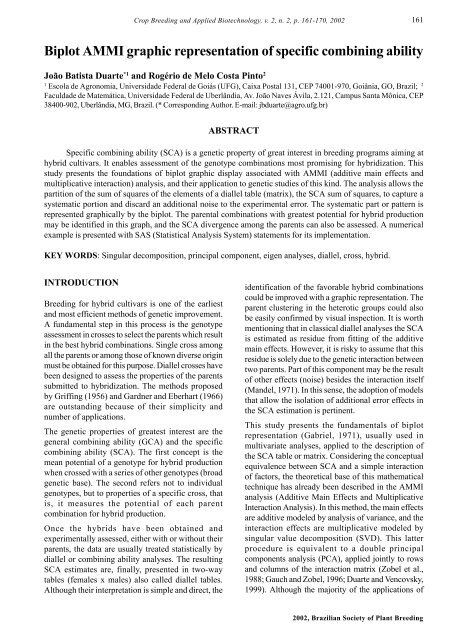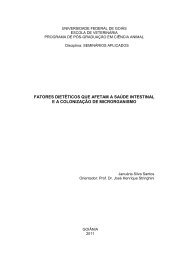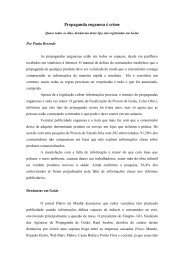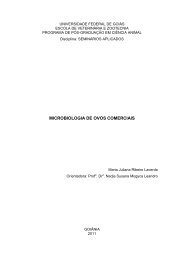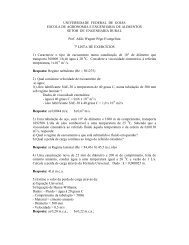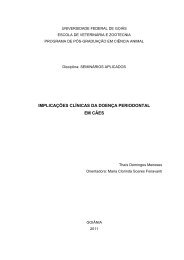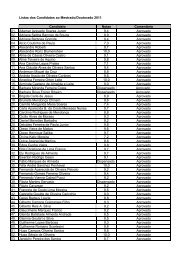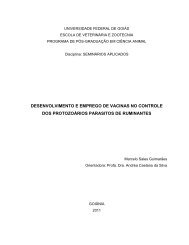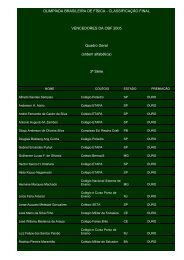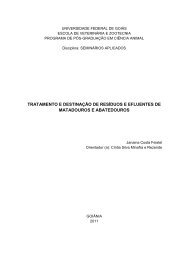Biplot AMMI graphic representation of specific combining ... - SBMP
Biplot AMMI graphic representation of specific combining ... - SBMP
Biplot AMMI graphic representation of specific combining ... - SBMP
Create successful ePaper yourself
Turn your PDF publications into a flip-book with our unique Google optimized e-Paper software.
Crop Breeding and Applied Biotechnology, v. 2, n. 2, p. 161-170, 2002161<strong>Biplot</strong> <strong>AMMI</strong> <strong>graphic</strong> <strong>representation</strong> <strong>of</strong> <strong>specific</strong> <strong>combining</strong> abilityJoão Batista Duarte *1 and Rogério de Melo Costa Pinto 21Escola de Agronomia, Universidade Federal de Goiás (UFG), Caixa Postal 131, CEP 74001-970, Goiânia, GO, Brazil; 2Faculdade de Matemática, Universidade Federal de Uberlândia, Av. João Naves Ávila, 2.121, Campus Santa Mônica, CEP38400-902, Uberlândia, MG, Brazil. (* Corresponding Author. E-mail: jbduarte@agro.ufg.br)ABSTRACTSpecific <strong>combining</strong> ability (SCA) is a genetic property <strong>of</strong> great interest in breeding programs aiming athybrid cultivars. It enables assessment <strong>of</strong> the genotype combinations most promising for hybridization. Thisstudy presents the foundations <strong>of</strong> biplot <strong>graphic</strong> display associated with <strong>AMMI</strong> (additive main effects andmultiplicative interaction) analysis, and their application to genetic studies <strong>of</strong> this kind. The analysis allows thepartition <strong>of</strong> the sum <strong>of</strong> squares <strong>of</strong> the elements <strong>of</strong> a diallel table (matrix), the SCA sum <strong>of</strong> squares, to capture asystematic portion and discard an additional noise to the experimental error. The systematic part or pattern isrepresented <strong>graphic</strong>ally by the biplot. The parental combinations with greatest potential for hybrid productionmay be identified in this graph, and the SCA divergence among the parents can also be assessed. A numericalexample is presented with SAS (Statistical Analysis System) statements for its implementation.KEY WORDS: Singular decomposition, principal component, eigen analyses, diallel, cross, hybrid.INTRODUCTIONBreeding for hybrid cultivars is one <strong>of</strong> the earliestand most efficient methods <strong>of</strong> genetic improvement.A fundamental step in this process is the genotypeassessment in crosses to select the parents which resultin the best hybrid combinations. Single cross amongall the parents or among those <strong>of</strong> known diverse originmust be obtained for this purpose. Diallel crosses havebeen designed to assess the properties <strong>of</strong> the parentssubmitted to hybridization. The methods proposedby Griffing (1956) and Gardner and Eberhart (1966)are outstanding because <strong>of</strong> their simplicity andnumber <strong>of</strong> applications.The genetic properties <strong>of</strong> greatest interest are thegeneral <strong>combining</strong> ability (GCA) and the <strong>specific</strong><strong>combining</strong> ability (SCA). The first concept is themean potential <strong>of</strong> a genotype for hybrid productionwhen crossed with a series <strong>of</strong> other genotypes (broadgenetic base). The second refers not to individualgenotypes, but to properties <strong>of</strong> a <strong>specific</strong> cross, thatis, it measures the potential <strong>of</strong> each parentcombination for hybrid production.Once the hybrids have been obtained andexperimentally assessed, either with or without theirparents, the data are usually treated statistically bydiallel or <strong>combining</strong> ability analyses. The resultingSCA estimates are, finally, presented in two-waytables (females x males) also called diallel tables.Although their interpretation is simple and direct, theidentification <strong>of</strong> the favorable hybrid combinationscould be improved with a <strong>graphic</strong> <strong>representation</strong>. Theparent clustering in the heterotic groups could alsobe easily confirmed by visual inspection. It is worthmentioning that in classical diallel analyses the SCAis estimated as residue from fitting <strong>of</strong> the additivemain effects. However, it is risky to assume that thisresidue is solely due to the genetic interaction betweentwo parents. Part <strong>of</strong> this component may be the result<strong>of</strong> other effects (noise) besides the interaction itself(Mandel, 1971). In this sense, the adoption <strong>of</strong> modelsthat allow the isolation <strong>of</strong> additional error effects inthe SCA estimation is pertinent.This study presents the fundamentals <strong>of</strong> biplot<strong>representation</strong> (Gabriel, 1971), usually used inmultivariate analyses, applied to the description <strong>of</strong>the SCA table or matrix. Considering the conceptualequivalence between SCA and a simple interaction<strong>of</strong> factors, the theoretical base <strong>of</strong> this mathematicaltechnique has already been described in the <strong>AMMI</strong>analysis (Additive Main Effects and MultiplicativeInteraction Analysis). In this method, the main effectsare additive modeled by analysis <strong>of</strong> variance, and theinteraction effects are multiplicative modeled bysingular value decomposition (SVD). This latterprocedure is equivalent to a double principalcomponents analysis (PCA), applied jointly to rowsand columns <strong>of</strong> the interaction matrix (Zobel et al.,1988; Gauch and Zobel, 1996; Duarte and Vencovsky,1999). Although the majority <strong>of</strong> the applications <strong>of</strong>2002, Brazilian Society <strong>of</strong> Plant Breeding
162 Crop Breeding and Applied Biotechnology, v. 2, n. 2, p. 161-170, 2002this analysis are related to genotype x environmentinteraction (GEI) studies, the authors suggest its perfectadaptation to line assessment in test crossings, such asthe diallel crosses.METHODOLOGYSingular value decompositionThe biplot <strong>graphic</strong> display is based on a matrix algebratool called singular value decomposition (SVD).Proposed by Eckart and Young (1936), this procedureallows writing a real matrix B, <strong>of</strong> rank p, as a sum <strong>of</strong>p orthogonal unitary rank matrices:B (lxc) =p∑ λ kk=1u k v k ’where: k=1, 2, ..., p and p ≤ min{l , c}and λ kis the k th singular value <strong>of</strong> B (the square root<strong>of</strong> the k th non-zero eigenvalue <strong>of</strong> BB’ or B’B), and u kand v k’ are the associated singular vectors, columnvector and row vector respectively.When the sum for k is applied only to the n first terms(with n
Crop Breeding and Applied Biotechnology, v. 2, n. 2, p. 161-170, 2002163only the few first terms (one, two or three) alreadydescribe a high proportion <strong>of</strong> this sum <strong>of</strong> squares. Thisallows the description <strong>of</strong> the SCA using a parsimoniousmodel (in the sense <strong>of</strong> using few degrees <strong>of</strong> freedom)and with good capacity to explain the original variabilitypresent in the matrix. Therefore, the analysis allowsa interpretation <strong>of</strong> the SS SCAby an approximation <strong>of</strong>rank n <strong>of</strong> the SCA matrix. As n is possibly smallerthan p (e.g. n =1, 2 or 3) the analysis results in aninformative model which can be represented<strong>graphic</strong>ally, since a complex p-dimensional space isrepresented in a bi or tridimensional graph.In the context <strong>of</strong> the <strong>AMMI</strong> method, the objective <strong>of</strong>the analysis is to describe the interaction by a reducednumber <strong>of</strong> axes. It is expected that, successively, eachaxis will capture a smaller portion <strong>of</strong> the patternunderlying to the interaction (general law whichgoverns the phenomena) and more noise present inthe data. Thus, a simpler model would discard a highproportion <strong>of</strong> noise which has no agronomic interestand can hamper good predictions, retaining mainlythe portion rich in deterministic information (Gauchand Zobel, 1988; Gauch, 1990). This separation inpattern and noise effects may also be expressed interms <strong>of</strong> sum <strong>of</strong> squares:p222SS SCA = ∑ λ = ( ∑ λ ) + ( ∑ λ )nkkkk= 1 k= 1 k= n+1= (SS SCA_pattern) + (SS SCA_noise).The biplot <strong>graphic</strong> displayAn important property <strong>of</strong> the SVD approximation isits allowance for the <strong>representation</strong> <strong>of</strong> effects <strong>of</strong> eachrow and <strong>of</strong> each column in a single graph calledbiplot. The name does not come from the spacedimension <strong>of</strong> <strong>representation</strong>, but from the fact that itdisplays simultaneously the rows and the columns <strong>of</strong>the matrix.To understand the mathematical origin <strong>of</strong> a biplotconsider the SVD n-approximation for the B matrix<strong>of</strong> rank p>n: ˆn ~~ ~ ~B( fxm)= ∑ k= 1 λkukv′k= USV′; where U( fxn)has~in its columns only the n first u (fx1)vectors; V ′( nxm)has~in its rows the n first v’ (1xm)vectors; and S( n)is thediagonal matrix with the first singular values,λ 1,λ 2,...,λ n(Duarte and Vencovsky, 1999). Theexpression may further be written as:Bˆ =~~ 1/ 2 ~ 1/ 2 ~( U S )( S V ′); or simply Bˆ =~ ~( G )( H ′), where~G( fxn)=~~ 2~( U S1/ ) and H ′( nxm)= ~ 1/ 2 ~( S V ′). Thus, ~ G matrixwill have f vectors called row markers, each one withn elements, the coordinates <strong>of</strong> the females (F) forpeach singular axis selected. Similarly, ~ H ′ will have mcolumn markers, each also with n elements,corresponding to the male (M) coordinates for thesame n axes. Given that these axes are orthogonal,the f females and m males can be plotted in a singlecartesian system <strong>of</strong> n perpendicular axes. In practice,similar to the scatter plots in PCA, the rank <strong>of</strong> theapproximate matrix (n) to be displayed should be one,two or three, which would allow a <strong>graphic</strong><strong>representation</strong> in one, two or three dimensions,respectively.A property <strong>of</strong> biplot <strong>representation</strong> is that any element<strong>of</strong> the approximate matrix is exactly the inner product<strong>of</strong> the vectors (markers) corresponding to its row andto its column (Gabriel, 1971). In this case, the productbetween the coordinates <strong>of</strong> the i th female and the j thmale yields the expected SCA value for that hybridcombination ( ŝ<strong>AMMI</strong>ij ). Clearly, this value does notcorrespond to that in the diallel table because thebiplot represents the SVD n-approximation <strong>of</strong> theoriginal B matrix. However, it is expected that thisprediction, rich in pattern, is closer to the real SCA(s ij) than the values ŝ ij <strong>of</strong> the diallel table, which arepotentially rich in noise (Gauch, 1990). In this sense,a male/female pair with coordinates <strong>of</strong> highmagnitude and the same signal has high SCA (positiveinteraction), characterizing a favorable combinationfor hybridization. On the other hand, a combinationwhose coordinates have opposite signs and negativeSCA is unfavorable. Thus the intergroup genotypedistances (F/M) have inverse interpretation in relationto the distance visualized in the graph, that is, pointsclose together do not indicate genotypic similarity butrather affinity for hybrid combination.On the other hand, inspecting only the female (ormale) markers, it is possible to assess the intragroupdivergences. In this case, close points indicate greatergenotypic similarity. In complete diallels, the femalesand males are the same genotypes and, therefore, suchinspection would enable the assessment <strong>of</strong> thedivergence among all the parents. Thus for genotypeclustering, it would be enough to plot only the femalemarkers (or the males) as in PCA display. However,in this case the opportunity to <strong>graphic</strong>ally predict theSCA magnitude and to identify the most promisinghybrid combinations would be lost.APPLICATIONTo illustrate the use <strong>of</strong> the biplot <strong>graphic</strong> display inSCA description, Griffing (1956) method IV results2002, Brazilian Society <strong>of</strong> Plant Breeding
164 Crop Breeding and Applied Biotechnology, v. 2, n. 2, p. 161-170, 2002(diallel with F1 hybrids, without parents and reciprocals) were taken. The ŝij estimates for grain yield in maizeare expressed by the symmetric B (9x9)matrix (F indicates females, and M, males):M1 M2 M3 M4 M5 M6 M7 M8 M9B =0.00 4.94 14.46 -2.76 2.80 -12.31 -16.93 -8.67 18.47 F14.94 0.00 -6.54 14.14 8.90 5.68 13.07 -2.47 -37.73 F214.46 -6.54 0.00 -29.94 19.01 15.80 4.48 -6.96 -10.31 F3-2.76 14.14 -29.94 0.00 11.50 -8.21 3.77 -19.47 30.97 F42.80 8.90 19.01 11.50 0.00 -36.16 -0.77 4.99 -10.27 F5-12.31 5.68 15.80 -8.21 -36.16 0.00 -10.78 32.77 13.22 F6-16.93 13.07 4.48 3.77 -0.77 -10.78 0.00 5.66 1.50 F7-8.67 -2.47 -6.96 -19.47 4.99 32.77 5.66 0.00 -5.85 F818.47 -37.73 -10.31 30.97 -10.27 13.22 1.50 -5.85 0.00 F9The matrix symmetry comes from the assumption <strong>of</strong>no reciprocal effects, although the analysis issufficiently generic to accommodate non-symmetricmatrices. The SCA mean square is 339.44, with27 degrees <strong>of</strong> freedom, which corresponds to:SS SCA=9164.28 (Griffing, 1956). The SS <strong>of</strong> the matrixelements ( ∑ 2 2bij= ∑ $s ij= 18328.55) is then equivalent totwice the SS SCA( ŝ ij values repeated above and belowthe main diagonal). Therefore, the partition <strong>of</strong> the sum<strong>of</strong> square <strong>of</strong> the matrix elements corresponds topartitioning the SS SCA.As mentioned earlier, the SVD decomposition <strong>of</strong> theB matrix is: B=USV’. The U, S and V matrices, thatdetermine this partition, can be obtained using acomputer program for matrix algebra. The Proc IML(interactive matrix language procedure) <strong>of</strong> theSAS (Statistical Analysis System) can be used, forexample, with the syntax “call svd (U,S,V,B);”. Theresults <strong>of</strong> the application <strong>of</strong> this command are thematrices:i) U (9x8)matrix <strong>of</strong> singular vectors associated with rows (females):0.2640 0.1759 -0.1622 0.0515 0.5091 0.5569 0.4353 -0.0210-0.3450 -0.3612 -0.0589 -0.4124 -0.3872 0.0198 0.5486 -0.1207-0.3671 0.2619 0.2526 -0.2661 0.5169 -0.3951 -0.1281 -0.3335-0.0160 0.5778 -0.5138 0.2488 -0.3196 -0.3324 0.1029 0.0760U = 0.3470 -0.3116 -0.2969 -0.4184 0.1818 -0.2327 -0.2924 0.48530.5286 -0.1209 0.5549 0.2996 -0.1352 -0.3438 0.2396 -0.05660.2452 0.0337 -0.0381 -0.1533 -0.3288 0.3567 -0.5120 -0.5524-0.3097 0.2535 0.4556 0.0130 -0.1937 0.3505 -0.1962 0.5676-0.3470 -0.5090 -0.1933 0.6373 0.1566 0.0201 -0.1975 -0.0446ii) S (8)matrix <strong>of</strong> singular values:S = diag {77.1865 63.3445 60.1728 54.7776 36.8391 17.6392 8.1048 1.7241}iii) V’ (8x9)matrix <strong>of</strong> singular vectors associated with columns (males):-0.2640 0.3450 0.3671 0.0160 -0.3470 -0.5286 -0.2452 0.3097 0.3470-0.1759 0.3612 -0.2619 -0.5778 0.3116 0.1209 -0.0337 -0.2535 0.5090-0.1622 -0.0589 0.2526 -0.5138 -0.2969 0.5549 -0.0381 0.4556 -0.1933V’ = 0.0515 -0.4124 -0.2661 0.2488 -0.4184 0.2996 -0.1533 0.0130 0.63730.5091 -0.3872 0.5169 -0.3196 0.1818 -0.1352 -0.3288 -0.1937 0.1566-0.5569 -0.0198 0.3951 0.3324 0.2327 0.3438 -0.3567 -0.3505 -0.02010.4353 0.5486 -0.1281 0.1029 -0.2924 0.2396 -0.5120 -0.1962 -0.19750.0210 0.1207 0.3335 -0.0760 -0.4853 0.0566 0.5524 -0.5676 0.04462002, Brazilian Society <strong>of</strong> Plant Breeding
Crop Breeding and Applied Biotechnology, v. 2, n. 2, p. 161-170, 2002165Note that the S matrix <strong>of</strong> non-null singular values is<strong>of</strong> 8x8 dimension indicating that the rank <strong>of</strong> B is alsop=8, which corresponds to the number <strong>of</strong> parentsminus one. Thus the SS SCAmay be partitioned in upto eight components (IPCA axes) as shown in Table1. In the present case (complete diallel), eachcomponent corresponds to half the square <strong>of</strong> eachsingular value, that is: SS SCA(IPCAk)=( λ 2 k)/2, withk=1,2,...,8. In the partial diallels (non-symmetricmatrices and possibly rectangular matrices) thepartition is direct, without division by two. In thisexample, the biplot <strong>representation</strong> <strong>of</strong> the SCA isillustrated taking the first three singular axes.Before constructing the biplot <strong>graphic</strong> display it isnecessary to obtain the G and H’ matrices, such thatG=US 1/2 and H’=S 1/2 V’ (so that B=GH’):i) G (9x8)matrix <strong>of</strong> row markers (females F1, F2, ...., F9):G =2.3198 1.4001 -1.2579 0.3811 3.0903 2.3389 1.2392 -0.0276 F1-3.0311 -2.8750 -0.4565 -3.0524 -2.3502 0.0834 1.5617 -0.1585 F2-3.2249 2.0848 1.9591 -1.9692 3.1374 -1.6595 -0.3646 -0.4379 F3-0.1409 4.5983 -3.9856 1.8411 -1.9398 -1.3960 0.2928 0.0998 F43.0482 -2.4803 -2.3030 -3.0966 1.1035 -0.9773 -0.8325 0.6372 F54.6443 -0.9626 4.3047 2.2172 -0.8207 -1.4441 0.6821 -0.0743 F62.1540 0.2680 -0.2958 -1.1342 -1.9958 1.4980 -1.4577 -0.7254 F7-2.7205 2.0173 3.5341 0.0964 -1.1755 1.4722 -0.5587 0.7452 F8-3.0488 -4.0508 -1.4991 4.7167 0.9508 0.0844 -0.5623 -0.0585 F9ii) H’ (8x9)matrix <strong>of</strong> column markers (males: M1, M2,...M9):H’=M1 M2 M3 M4 M5 M6 M7 M8 M9-2.3198 3.0311 3.2249 0.1409 -3.0482 -4.6443 -2.1540 2.7205 3.0488-1.4001 2.8750 -2.0848 -4.5983 2.4803 0.9626 -0.2680 -2.0173 4.0508-1.2579 -0.4565 1.9591 -3.9856 -2.3030 4.3047 -0.2958 3.5341 -1.49910.3811 -3.0524 -1.9692 1.8411 -3.0966 2.2172 -1.1342 0.0964 4.71673.0903 -2.3502 3.1374 -1.9398 1.1035 -0.8207 -1.9958 -1.1755 0.9508-2.3389 -0.0834 1.6595 1.3960 0.9773 1.4441 -1.4980 -1.4722 -0.08441.2392 1.5617 -0.3646 0.2928 -0.8325 0.6821 -1.4577 -0.5587 -0.56230.0276 0.1585 0.4379 -0.0998 -0.6372 0.0743 0.7254 -0.7452 0.0585The dotted rows in G and H’ delimit at the left andabove the G ~ and H ~ ′ matrices, respectively, and thecoordinates corresponding to females and to malesfor the construction <strong>of</strong> a three dimensional biplot(biplot-<strong>AMMI</strong>3). This <strong>representation</strong> captures74.15% <strong>of</strong> the original SS SCA(Table 1) and thepredominant pattern associated with the SCA. Thus,it is expected that the SCA predictions obtained bythe SVD 3-approximation ( Bˆ ~ ~ =G H ′) should be morerealistic than those presented in the original diallel table(matrix B). If only the first two columns <strong>of</strong> G and thefirst two rows <strong>of</strong> H’ were taken, the biplot would berepresented in a plan (biplot-<strong>AMMI</strong>2); however, itwould explain only 54.40% <strong>of</strong> the SS SCA. Finally, the<strong>AMMI</strong>ŝij values predicted by the SVD 3-approximation<strong>of</strong> the B matrix are expressed by:M1 M2 M3 M4 M5 M6 M7 M8 M9-5.76 11.63 2.10 -1.10 -0.70 -14.84 -5.00 -0.96 14.63 F111.63 -17.24 -4.68 14.61 3.16 9.35 7.43 -4.06 -20.20 F2Bˆ =2.10 -4.68 -10.91 -17.85 10.49 25.42 5.81 -6.06 -4.32 F3-1.10 14.61 -17.85 -5.28 21.01 -12.08 0.25 -23.74 24.17 F4-0.70 3.16 10.49 21.01 -10.14 -26.46 -5.22 5.16 2.70 F5-14.84 9.35 25.42 -12.08 -26.46 -3.97 -11.02 29.79 3.81 F6-5.00 7.43 5.81 0.25 -5.22 -11.02 -4.62 4.27 8.10 F7-0.96 -4.06 -6.06 -23.74 5.16 29.79 4.27 1.02 -5.42 F814.63 -20.20 -4.32 24.17 2.70 3.81 8.10 -5.42 -23.46 F92002, Brazilian Society <strong>of</strong> Plant Breeding
166 Crop Breeding and Applied Biotechnology, v. 2, n. 2, p. 161-170, 2002Considering the observed high correlation between Bˆand B ( r = 0.74 = 0. 86) it can be said that in thisexample the error associated with a decision based on Binstead <strong>of</strong> on Bˆ would not be great. It is justifiedbecause, under an adequate choice <strong>of</strong> the number <strong>of</strong>multiplicative terms (or singular axes), a low magnitudecorrelation between Bˆ and B is related to thepredominance <strong>of</strong> noise in the B matrix. Thus, in thissituation, it may be wrong to interpret the residues ŝ ijas reliable estimates <strong>of</strong> the true SCA (s ij).Based on the Bˆ matrix the following crosses wereoutstanding among the more favorable combinations:6x8, 3x6, 4x9 and 4x5 (female x male or vice-versa).Also, note that in the case <strong>of</strong> complete diallels andunder the assumption <strong>of</strong> no reciprocal effects, the SCAprediction matrix is also symmetric. Further, the SCA<strong>of</strong> each parent with itself (s jj) is estimated, allowinginferences on varietal heterosis (Cruz and Vencovsky,1989). The majority <strong>of</strong> these values were negative,indicating that this type <strong>of</strong> cross is not adequate forhybrid extraction. The parents identified by thenumbers 8, 6 and 7, in this order, should show greatervarietal heterosis than those <strong>of</strong> the numbers 9 and 2.Further note that, in spite <strong>of</strong> the arbitrariness <strong>of</strong> theassignment <strong>of</strong> zero values for the main diagonalelements <strong>of</strong> B, the analysis was able to predict thedistinct reaction <strong>of</strong> the parents when crossed withthemselves. This opens the perspective <strong>of</strong> predictingthe SCA from unavailable crosses, avoiding the needto assess all possible single crosses.The possibility <strong>of</strong> predicting the hybrid performance<strong>of</strong> non-realized crosses comes from the fact that theanalysis deals with the interaction (SCA) not only as aproperty <strong>of</strong> each parental combination, but also in anintegrated manner, as a phenomenon determinedtogether by rows and columns <strong>of</strong> the B matrix.However, if the major interest is for this type <strong>of</strong>prediction, it is recommended that one proceedsinteractively according to Gauch (1992). Furthermore,to predict the genotypic responses it is necessary totake into account the main effects associated with eachparent. Charcosset et al. (1993) used models withmultiplicative interaction terms (<strong>AMMI</strong> analysis) witha similar purpose <strong>of</strong> predicting the performance <strong>of</strong> linehybrids in maize, when the assessment <strong>of</strong> all the singlecrosses were not possible. The authors concluded thatthe models <strong>of</strong>fer the possibility <strong>of</strong> improving predictionefficiency, without supplementary measurements. Theproblem could also be treated by the mixed modelsapproach, obtaining the BLUP (best linear unbiasedpredictor) <strong>of</strong> the s ij<strong>of</strong> missing hybrids (Bernardo, 1996;André, 1999), followed by the SVD adjustment <strong>of</strong> thesepredictions.The coordinates <strong>of</strong> each parent, used to construct the<strong>graphic</strong>s, are summarized in Table 2. A SAS programto execute the analysis is freely available from theweb-address: www.agro.ufg.br.The relationships commented upon may be seen bylooking at the corresponding biplot. Figure 1, althoughbringing all the biplot-<strong>AMMI</strong>3 information, does notallow a perfect assessment <strong>of</strong> the relative distancesamong the parents because it is a three dimensionalgraph projected on the paper plane. Thus, for a morerigorous inspection, it is convenient to project the points<strong>of</strong> the 3-D space in at least two complementary planes,for example, IPCA1 vs. IPCA2 and IPCA1 vs. IPCA3(Figure 2). Therefore, the closeness between two points(genotypes) must always be confirmed by inspectionin these principal planes.Figures 1 and 2 summarize the potential <strong>of</strong> thedifferent parental combinations to produce hybrids.These <strong>graphic</strong>s do not explain the whole SCA value.However, according to the <strong>AMMI</strong> analysis concept(as in PCA), the true pattern <strong>of</strong> interaction (SCA) isTable 1. The partition <strong>of</strong> SS SCA(<strong>specific</strong> <strong>combining</strong> ability sum <strong>of</strong> the squares) by singular decomposition, proportionretained in each singular axis and accumulated percentage up to k th axis, in a diallel <strong>AMMI</strong> analysis.IPCA k SS IPCAk SS IPCAk /SS SCA % Accumulated1 2978.8753 0.3251 32.50532 2006.2649 0.2189 54.39753 1810.3817 0.1975 74.15234 1500.2918 0.1637 90.52345 678.5611 0.0740 97.92786 55.5711 0.0170 99.62547 32.8437 0.0036 99.98388 1.4862 0.0002 100.0000Total 9164.2760 1.0000 -2002, Brazilian Society <strong>of</strong> Plant Breeding
Crop Breeding and Applied Biotechnology, v. 2, n. 2, p. 161-170, 2002167described mainly by the first singular axes. Each axisis a linear combination <strong>of</strong> the rows and columns(vectors) which form the B matrix. As all these vectorscontain ŝij values, the axes represent SCA linearfunctions constructed with all the matrix data. Finally,as the successive axes capture ever less pattern andmore noise, discarding the latter becomes necessaryto avoid the incorporation <strong>of</strong> substantial errors in thedescription <strong>of</strong> the interaction.Conscious <strong>of</strong> these concepts and observing the pairs<strong>of</strong> points corresponding to each female and malecombination, the proximity between F6/M3, F6/M8,F4/M9 and F4/M5 can be depicted. This indicatesthat such combinations are promising for single crossproduction in this set <strong>of</strong> parents. A strongcharacteristic in all <strong>of</strong> them is the high magnitudeand same sign coordinates for the genotypes <strong>of</strong> eachpair. On the other hand, it can be deduced that thegenotypes with good GCA should have lowmagnitude coordinates (small interaction) as is thecase <strong>of</strong> parents 1 and 7 (Figure 1). These lines areshown to have high GCA in Griffing analysis (1956).Among the combinations with lower potential forhybrid production are: F2/M9, F6/M5 and F4/M8,all showing great distance among the respective F/Mpoints in the Figures 1 and 2. Further, the low potentialis also observed for crosses among the same genotype(F6/M6, F9/M9, etc.), which always show points inopposite position. It is interesting to note that theF3xM5 cross although shown as fairly favorable inTable 2. Coordinates <strong>of</strong> the parents for the three firstprincipal axes (IPCA1, IPCA2 and IPCA3) <strong>of</strong> a biplot<strong>graphic</strong> display, in a diallel <strong>AMMI</strong> analysis.Point Female/Male IPCA 1 IPCA 2 IPCA 31 F1 2.3197 1.4001 -1.25792 F2 -3.0311 -2.8749 -0.45653 F3 -3.2249 2.0848 1.95914 F4 -0.1408 4.5982 -3.98555 F5 3.0481 -2.4802 -2.30306 F6 4.6443 -0.9625 4.30467 F7 2.1540 0.2680 -0.29588 F8 -2.7205 2.0172 3.53419 F9 -3.0488 -4.0507 -1.499010 M1 -2.3197 -1.4001 -1.257911 M2 3.0311 2.8749 -0.456512 M3 3.2249 -2.0848 1.959113 M4 0.1408 -4.5982 -3.985514 M5 -3.0481 2.4802 -2.303015 M6 -4.6443 0.9625 4.304616 M7 -2.1540 -0.2680 -0.295817 M8 2.7205 -2.0172 3.534118 M9 3.0488 4.0507 -1.4990Figure 1. <strong>Biplot</strong> <strong>AMMI</strong>3 for <strong>specific</strong> <strong>combining</strong>ability (SCA) in maize grain yield <strong>of</strong> a diallel cross;the cubes identify female genotypes (F), and thepyramids, the male genotypes (M).the original diallel table, was shown to be onlyreasonable by the present analysis. This happenedbecause the <strong>AMMI</strong> method discards part <strong>of</strong> theinformation contained in the original matrix as <strong>of</strong>predominantly erratic in nature. The option for thebiplot-<strong>AMMI</strong>3 implied in disregarding 26% <strong>of</strong> theSS SCA. These results can be confirmed in the Bˆmatrix for ŝ <strong>AMMI</strong>ij prediction.When only one kind <strong>of</strong> marker is taken, for examplethe F points (or the M points), the divergences andsimilarities among the genotypes which make up theparent group can be assessed. Thus the divergencebetween genotypes 3 and 6 is notorious, as well asthose between 4 and 9. However, it is also evidentthe similarity between the genotypes 3 and 8, andbetween 2 and 9 (Figures 1 and 2). Observe also thatthe first principal axis (IPCA1), capturing 32% <strong>of</strong>the SCA, is strongly determined by the divergenceamong two groups <strong>of</strong> genotypes (2, 3, 8, 9) and (1, 5,6, 7). The two best hybrid combinations foundresulted exactly from the cross between genotypesbelonging to distinct groups (3x6 and 6x8). The twoother axes, each explaining about 20% <strong>of</strong> the referredvariability, relate more with intragroup genotypicdivergences. Therefore, the biplot display was shownto be an additional tool to guide the formation <strong>of</strong>heterotic groups and the planning <strong>of</strong> future crosses.CONCLUSIONSThe adoption <strong>of</strong> biplot-<strong>AMMI</strong> to represent the SCAallows a quick visualization <strong>of</strong> the favorable andunfavorable genotypic combinations for hybridproduction. The use <strong>of</strong> this <strong>graphic</strong> display also allowsa quick and easy assessment <strong>of</strong> the genotypicdivergences and similarities among the parents2002, Brazilian Society <strong>of</strong> Plant Breeding
168 Crop Breeding and Applied Biotechnology, v. 2, n. 2, p. 161-170, 2002Figure 2. Two first principal planes for <strong>specific</strong> <strong>combining</strong> ability (SCA) in maize grain yield <strong>of</strong> a diallel cross;F (females) identify the genotypes in the rows and M (males) the genotypes in the columns <strong>of</strong> the diallel table.involved in the diallel crosses. Further, the possibility<strong>of</strong> discarding an additional noise may guaranteeimprovements in estimates <strong>of</strong> SCA.Considering the integrated treatment which the<strong>AMMI</strong> analysis <strong>of</strong>fers to the data, it is possible topredict the SCA, even for hybrid combinations notassessed experimentally. This opens the perspective<strong>of</strong> incorporating this method <strong>of</strong> analysis, associatedwith biplot <strong>representation</strong>, in the routine procedures<strong>of</strong> prediction <strong>of</strong> hybrid means in breeding programs.RESUMORepresentação gráfica BIPLOT-<strong>AMMI</strong> para acapacidade específica de combinaçãoNo melhoramento para a obtenção de híbridos, umapropriedade genética de grande interesse é acapacidade específica de combinação (CEC).Através dela é possível avaliar as combinações degenótipos mais promissoras à hibridação. O presentetrabalho tem o objetivo de apresentar os fundamentosda representação biplot, associada à análise <strong>AMMI</strong>(additive main effects and multiplicativeinteraction), bem como sua aplicação aos estudosgenéticos dessa natureza. A análise permite umadecomposição da soma de quadrados dos elementosda tabela (matriz) dialélica, a soma de quadrados paraCEC, de maneira a captar uma porção sistemática edescartar um resíduo adicional ao erro doexperimento. A parte sistemática ou padrão é, então,representada graficamente por meio do biplot. Nestegráfico pode-se identificar as combinações degenitores com maior potencialidade para a produçãode híbridos, bem como avaliar a divergência entre osparentais, em termos de CEC. Um exemplo numéricoé apresentado com instruções computacionais para asua implementação.REFERENCESAndré, C.M.G. 1999. Avaliação da melhor prediçãolinear não tendenciosa BLUP associada ao uso demarcadores moleculares na análise dialética. M.S.Thesis. Universidade Federal de Lavras, Lavras.Bernardo, R. 1996. Best linear unbiased prediction <strong>of</strong>maize single-cross performance. Crop Science. 36:50-56.Charcosset, A.; Denis, J.B.; Lefort-Buson, M. andGallais, A. 1993. Modelling interaction from topcrossdesign data and prediction <strong>of</strong> F1 hybrid value.Agronomie. 13:597-608.Cruz, C.D. and Vencovsky, R. 1989. Comparision <strong>of</strong>some methods <strong>of</strong> diallel analysis. Revista Brasileirade Genetica. 12:425-438.Duarte, J.B. and Vencovsky, R. 1999. Interaçãogenótipos x ambientes, uma introdução à análise<strong>AMMI</strong>. Série Monografias, n.9. Sociedade Brasileirade Genética, Ribeirão Preto.Eckart, C. and Young, G. 1936. The approximation<strong>of</strong> one matrix by another <strong>of</strong> lower rank.Psychometrika. 1:211-218.Gabriel, K.R. 1978. Least squares approximation <strong>of</strong>matrices by additive and multiplicative models. J.R. Statist. Soc. 40:186-196.Gabriel, K.R. 1971. The biplot <strong>graphic</strong> display <strong>of</strong>matrices with application to principal componentanalysis. Biometrika. 58:453-467.Gardner, C.O. and Eberhart, S.A. 1966. Analysis and2002, Brazilian Society <strong>of</strong> Plant Breeding
Crop Breeding and Applied Biotechnology, v. 2, n. 2, p. 161-170, 2002169interpretation <strong>of</strong> the variety cross diallel and relatedpopulations. Biometrics. 22:439-452.Gauch, H.G. 1990. Full and reduced models for yieldtrials. Theoretical Applied Genetics. 80:153-160.Gauch, H.G. and Zobel, R.W. 1996. <strong>AMMI</strong> analysis<strong>of</strong> yield trials. p.85-122. In: Kang, M.S. and Gauch,H.G.(Eds.). Genotype by environment interaction.CRC Press, Boca Raton.Gauch, H.G. and Zobel, R.W. 1988. Predictive andpostdictive success <strong>of</strong> statistical analysis <strong>of</strong> yieldtrials. Theoretical Applied Genetics. 76:1-10.Gauch, H.G. 1992. Statistical analysis <strong>of</strong> regionalyield trials: <strong>AMMI</strong> analysis <strong>of</strong> factorial designs.Elsevier, New York.Gollob, H.F. 1968. A statistical model whichcombines features <strong>of</strong> factor analytic and analysis <strong>of</strong>variance techniques. Psychometrika. 33:73-115.Good, I.J. 1969. Some applications <strong>of</strong> the singulardecomposition <strong>of</strong> a matrix. Technometrics. 11:823-831.Griffing, B. 1956. Concept <strong>of</strong> general and <strong>specific</strong><strong>combining</strong> ability in relation to diallel crossingsystems. Austr. J. Biol. Sci. 9:463-493.Mandel, J. 1971. A new analysis <strong>of</strong> variance modelfor non-additive data. Technometrics. 13:1-18.Zobel, R.W.; Wright, M.J. and Gauch, H.G. 1988.Statistical analysis <strong>of</strong> a yield trial. Agronomy Journal.80:388-393.Received: August 20, 2001;Accepted: May 23, 2002.2002, Brazilian Society <strong>of</strong> Plant Breeding
170 Crop Breeding and Applied Biotechnology, v. 2, n. 2, p. 161-170, 20022002, Brazilian Society <strong>of</strong> Plant Breeding


